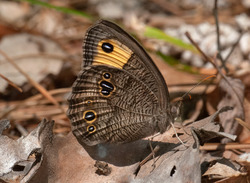Common Wood Nymph Cercyonis pegala
Butterfly: Wingspan: 1¾ - 3 inches (4.5 - 7.6 cm). Wings are brown. The upperside of the forewing has 2 large yellow-ringed eyespots. The lowerside of the hindwing has a variable number of small eyespots. Alabama's Common Wood Nymphs have a yellow or yellow-orange patch on the outer part of the forewing.
ID Tip: Large yellow forewing patches with two very prominent eyespots. Another popular common name was once "Goggle-Eye."
Egg: Pearly orb laid singly on host plant.
Caterpillar: Green with dark green lower stripe and light side stripes.The body is covered with very short, whitish hiars. Head is rounded. Two small tails are light brown. Tiny, first stage (instar) caterpillars are the overwintering stage.
Chrysalis: Yellow-green with white on upper surface and along the edge of the wing case. Often hangs from a grass stem.








































